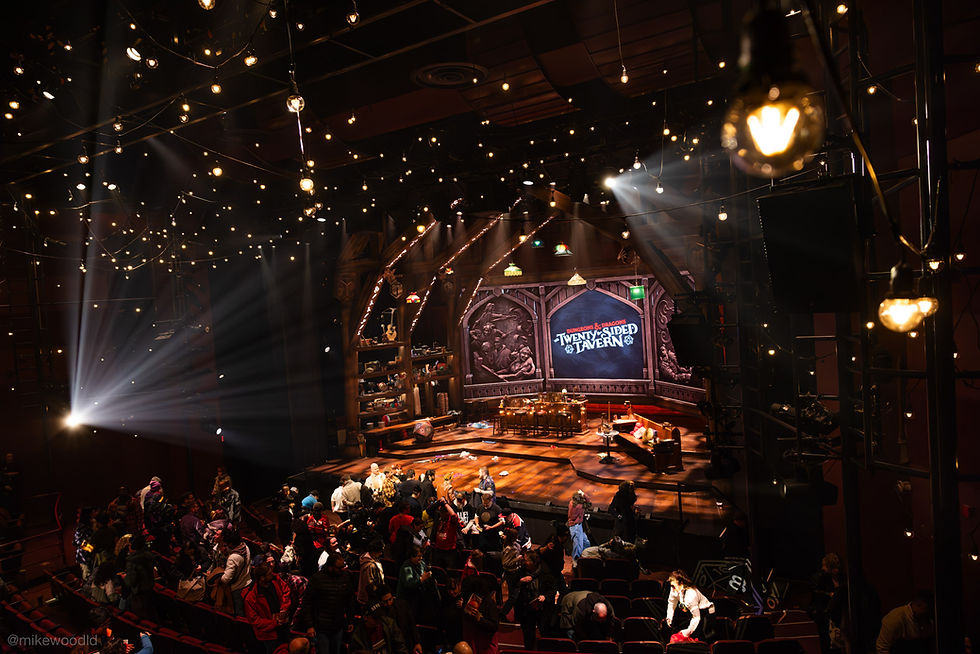
The Twenty-Sided Tavern
Broadway’s First Interactive Fantasy Adventure
A New Kind of Theatre
When The Twenty-Sided Tavern opened Off-Broadway, it introduced something never before seen on a New York stage: a fully interactive, audience-driven theatrical experience based on the world of Dungeons & Dragons. Each performance unfolds differently, driven by live audience votes and a branching narrative structure. For the creative team, this format offered a thrilling new canvas — but for the technical crew, it presented a unique set of challenges.
With every performance shaped by live decisions, the production required a control system capable of adapting on the fly. The show needed to track dozens of variables in real time, trigger different lighting and sound states based on player choices, and manage scene transitions that could change from one night to the next — all without sacrificing precision, safety, or creative flow.
Chet Miller, a Project Technology Specialist with 4Wall and the show control designer for The Twenty-Sided Tavern, understood from the beginning that traditional tools would fall short. “This wasn’t just about calling cues,” they explained. “It was about designing a system that could react like a game engine — but operate with the reliability of a Broadway show.”
The Right Tool for the Job
Miller had been following Vertex closely during 4Wall’s evaluations of next-generation media servers and show control platforms. From their first interactions with it, they recognized that Vertex was something different — not just a media server with scripting, but a scripting-first environment that happened to include powerful media tools. That architecture made it the perfect choice for a production where story logic, not just video playback, needed to take center stage.
“From the first day in the workshop,” Miller said, “I knew Vertex was the right answer.”
Unlike traditional shows where show control responsibilities are split across departments, The Twenty-Sided Tavern was given the rare opportunity to design a unified control system from the ground up. That decision paid off: with Vertex at the core, the production could consolidate logic, media, cueing, and variable handling into one cohesive, programmable environment.
Engineering for Chaos — and Control
Designing a show that changes every night isn’t just a creative challenge — it’s a technical one. To manage the production’s branching structure, Miller divided the show into 20 narrative “blocks,” each assigned its own minute on the Vertex timeline. This allowed the system to quickly jump between scenes with a single command, triggered either by audience decisions or by the performers themselves.
At the heart of this system were Vertex’s variable tools. Every choice the audience made was captured in real time and stored within Vertex as a variable object. These variables informed everything — from which lighting looks were activated, to which soundscape was triggered, to whether the next scene would take place in a forest, tavern, or dungeon.
One particularly complex moment came in Act II, when the show could branch into one of three “bonus game rooms,” depending on a decision made much earlier. Vertex handled the logic effortlessly. “We just stored the game room selection from Act I, and ran a simple comparison when the moment arrived,” Miller explained. “From there, different content was triggered — no manual intervention needed.”
Because cues in Vertex can be built from smaller sub-scripts, Miller created a modular system that allowed for fast editing and reusability. This design proved essential not only during development but throughout previews and tech rehearsals, where changes came fast and often. “Every cue of the show was a tidy combination of small scripts,” they said. “It made troubleshooting and adjusting incredibly fast.”
Real-Time Flexibility, Rehearsal-Proof Reliability
One of the standout advantages of using Vertex was its ability to support live programming, even during technical rehearsals and performances. The team ran the show on a primary system while making real-time edits on a backup machine. This setup allowed Miller to refine scripts, adjust variables, and test changes without interrupting rehearsals or delaying the production schedule.
This flexibility proved vital when creative decisions evolved during the process. At one point, the writers decided to rewrite the show’s ending just hours before a preview performance. Thanks to the system’s structure and Vertex’s scripting tools, a fully programmed and tested version of the new ending was ready that same evening.
“Being able to say ‘yes’ every time the creative team had a new idea — that was the real power of Vertex,” Miller recalled. “In the Chicago run, they had to force a specific path because the logic wasn’t ready. Now, we had the ability to go anywhere in the story, live, and without limits.”
Collaboration Across Disciplines
Beyond powering internal logic, Vertex also became the central bridge between departments. Lighting, sound, video, and stage management all received their triggers from the system. The stage manager was given a live view of cue progression, next steps, and available performer buttons. Onstage, actors used Stream Decks to trigger transitions and effects — seamlessly integrated into the Vertex system.
Because of this integration, the entire production team could operate as a single unit, even as the show’s path changed nightly. Communication was streamlined, decisions were coordinated, and cue reliability remained consistent — regardless of where the story went.
The Verdict: Freedom Through Structure
Looking back, Miller doesn’t point to one dramatic moment where the system "saved the day" — because it didn’t have to. “Vertex didn’t save the day,” they said. “Vertex made the day. It was the heart of the whole production. The Twenty-Sided Tavern ran because of Vertex.”
By combining real-time programming power with intuitive scripting, reliable media playback, and unmatched flexibility, Vertex gave the production team the confidence to embrace the chaos of live storytelling — without ever losing control.
Credits
© 4wall
Project Gallery



